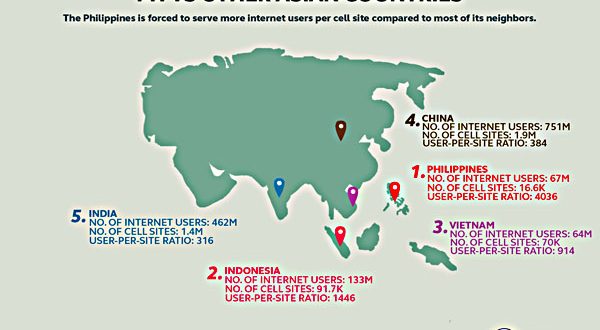BEING one of the Asian countries with lowest cell site density, the Philippines is forced to serve more internet users per cell site compared to most of its neighbors. Setting up more telecommunications infrastructure continues to be challenging in the country, hampered by lengthy permit applications and some uncooperative stakeholders.
Latest data from TowerXchange and We Are Social showed that user-per-cell site density in the Philippines is now about 4,036, based on estimates of 16,600 total cell sites against internet users of around 67 million internet users as of first quarter of the year. This shows a stark difference when compared to some of its neighboring countries like India, Indonesia, China, and Vietnam.
India, with 1.459 million cell sites against 462 million internet users, has a user-per-site density of 316. Indonesia, with over 91,700 cell sites against 132.7 million internet users, has a user-per-site density of 1,446. China, with 1.95 million cell sites against 751 million internet users, has a user-per-site density of 384. While Vietnam, with 70,000 cell sites against 64 million internet users, has a user-per-site density of 914.
The disproportionate number of cell sites versus internet users in the Philippines is mainly attributed to difficulties in securing permits from various local government units (LGUs), homeowner associations (HOAs), and other stakeholders, causing considerable delay in the construction of such facilities, Globe Chief Technology and Information Officer Gil Genio said.
For Globe Telecom, more cell sites are needed as its network saw mobile data traffic soar by 49 percent to 641 Petabytes during the first nine months of 2018, from 430 Petabytes recorded in the same period in 2017. As of end September 2018, Globe clocked in 65.4 million mobile customers, the majority of which are internet users. For instance, around 246,700 Globe active customers in Cotabato City in Maguindanao are forced to share only 13 cell sites. This shows the urgent need to build more towers in order to serve the current data traffic that continuously grows exponentially over the past months.
“Consumer demand for mobile data is growing at an explosive rate. This means more and more cellular towers have to be deployed to keep up with the demand. But deployment is only the final step to a potentially long, costly site acquisition process,” Genio said.
Lengthy permits
To cater to the rising demand for data, Globe has been accelerating the deployment of cell sites across the Philippines. This is part of its initiative to continue building on its network capacities for better quality of internet experience. But in the absence of regulations on the construction of passive telecommunications infrastructure, LGUs impose their own requirements, slowing down the deployment of cell sites.
Aside from LGU permits, HOAs, exclusive subdivisions, and building administrators also impose certain guidelines and requirements based on Housing and Land Use Regulatory Board (HLURB) Resolution No. R-626 issued in 1998. From negotiations and documentation of prospective cell site location to securing structural permits and approvals, Globe estimates an average of eight months and over 25 permits before it can build one cellular tower.
Non-present health risks
Several exclusive villages and HOAs in the Philippines also refuse to have network-boosting cell sites deployed in their vicinity because of unfounded health risk linked with exposure to radiation emitted from cell sites.
Global authorities in radiation safety, like Environmental Protection Agency (EPA) and World Health Organization (WHO), have affirmed that proximity to cell sites does not cause any known health risks, contrary to what many HOAs and exclusive villages in the country believe. Even the Department of Health has taken all the necessary precautions in ensuring that the Philippine standard of thermal emissions from local cell sites are at least four times lower than what has been approved globally.
In a bid to bring the Philippines closer to first-world internet connectivity, Globe continues to push for cooperation among all stakeholders, from the public sector, down to the barangay level, property developers, and homeowners.
For more information, please contact:
Yoly C. Crisanto
SVP, Corporate Communications
Globe Telecom, Inc.
Email Address: [email protected]
Globe Press Room: http://www.newsroom.globe.com.ph/
Twitter: @talk2GLOBE │ Facebook: http://www.facebook.com/globeph
 HATAW! D'yaryo ng Bayan hatawtabloid.com
HATAW! D'yaryo ng Bayan hatawtabloid.com





















